My latest DeHaan Services article, " To Untangle Two Toronto Triathlons in 2012", is a guide to the two triathlon events that will be held in Toronto in the summer of 2012. 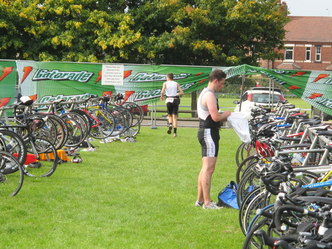 "North West Triathlon" image by (The contributor of this photo is David Hawgood) While following up on " Prepare for the 2012 Toronto Triathlon Event" yesterday, I learned that there is another triathlon in Toronto. It has a different date, venue, organizer, and set of distances. It seemed that the least I could do was to share this with my readers, who might otherwise be as confused as I was when I first found the references.As always, I also publicize my article in my Xanga blog (" Two Toronto Triathlons in 2012" ).
Writing Tip
This writing tip might be new (to this blog).
Follow up on previous news items.
Pay special attention to your popular articles, since people are still reading them.
Also follow up if you had written about a topic ahead of time. I had only expected to be able to add a few words to my older article, and only if the organizers had released any new information. My specific goal was to pass along "where to register for the race", since I had not learned that back in October.
Here is an example of a different opportunity to follow up. Suppose you had written about "flu shots" early in the season. You could follow up with "vaccination rates went up/down or held steady", as well as "health officials report more/fewer/similar# of cases of influenza".
You're creative about your topics. Be creative in finding ways to keep your readers informed about the aftermath.
To use a sports metaphor: don't just swing, follow through.
I'm pleased with the timing for the publication of my latest Environmental Graffiti article. " Groundhog Day: The Weather Predicting Woodchuck!" went public just before the annual frenzy for this festivity.  "Groundhog in Ottawa, Ontario" image by joy_acharjee Nameless but as Canadian as Wiarton Willie, this Ottawa groundhog is a fine specimen.
Writing Tip
Today's writing tip covers a new topic: why did I choose to submit this article to Environmental Graffiti rather than Suite 101?
The reason is simple. My Google SERP (Search Engine Results Page) for "groundhog inurl:.suite101.com" shows over 900 results. The same search for the Environmental Graffiti URL shows only one article, in which "groundhog" is mentioned in a list of rodents.
There is no point in fighting with fellow authors in one market, if another has not yet been touched.
That's why I decided to fill "the groundhog gap" at Environmental Graffiti, rather than adding to the volume at Suite 101.
Always check the "competition" before deciding where to submit your article. Better yet, make that decision before deciding on the slant or angle your article should take. Different online magazines have different goals: how-to, scientific reference, cute images, children's education, or whatever.
Other Publicity for the Groundhog
As always, my article is publicized in DeHaan Services (" Groundhog Day for Canadian Woodchuck Weather Prediction") and in my Xanga blog (" Your Briefing for Groundhog Day"). May I also thank the IUCN for their assessment of the safety or danger of this species, as reported in " Marmota monax".
My next article for Decoded Science is " Repercussions from the Richard Paradox". I'm fascinated by the fact that mathematics can lead to paradoxes and impossible situations. After all, we tried to define simple axioms in order to build consistent and reliable mathematical structures. Then we create paradoxes. Why did this blog post start as a preview? Prior to publication in another person's web site, I want to lay claim to the copyright for any new image that I made for that article. "For All x, the Function of x" by Mike DeHaan Voila: my claim to this magnificent art. Note that I added a border so it does not fade into the surrounding white space.
I was disappointed that the inverted-A "for all" symbol was not copied properly from my Word document into my Paint program. It became a question mark. So much for believing that highlighting the section and pressing <PrtScn> would send a pure image to the Clipboard, to be pasted into Paint.
Self Promotion for the Richard Paradox
As always, I also publicize my article in DeHaan Services (" The Richard Paradox at Decoded Science") and in my Xanga blog (" The Paradox of Richardian Numbers"). Writing Tip
It's important to have images in online articles.
The writing tip is: when no-one can take a suitable photograph, consider making an image yourself.
If you lack artistic talent, standard computer programs such as word processors, spreadsheets and presentation tools may have appropriate elements that you can manipulate to produce a graphic.
By the way: my article was just crying out for a picture of mathematician Jules Richard, but the only image I could find was almost certainly under copyright. Rather than ask permission, I simply added a link to their site in my main article. The bonus writing tip is to follow the rules and respect copyright.
My latest DeHaan Fitness... blog post is " Weight Loss Risks for Toronto Mayor Rob Ford". The topic of "risks involved in speedy weight loss" is important in itself. If you're thinking about a crash diet, please take the time to read my analysis of what Mayor Ford is risking. However, this blog is about writing! So, on to the "local angle"...once we get past the "before" picture. "Mayor Rob Ford in David Pecaut Square, Toronto" image by West Annex News. Here is the local angle on Toronto Mayor Rob Ford, in a "before the diet" image.
Local Angles for Your Writing
No matter where you live, local news will get your attention. Might it also get your readers' attention? Several million people might potentially scan the Internet for news about Toronto's mayor. I suspect far fewer would look for a generic "scare story" about unsafe diet plans. Using a local "angle" on a universal truth can help make it more real for your audience. A story about a hypothetical situation is far less compelling than one about a real victim. In this case, we have a locally famous real person, who is not yet, and hopefully will not be, a victim. On a personal level, I found myself thinking about Mayor Ford's weight loss announcement for several days. Normally I might not pay much attention to his actions; but when I realized this had caught my attention, I decided to follow my interest and write the blog post. Finally, I also recently joined an online semi-social bookmark site called Zoom It., which is dedicated to Canadian content. An article must have Canadian content, or be hosted on a clearly Canadian site, to be listed there. Many of my articles don't have that Canadian connection; but by hooking this blog post to Toronto's mayor, the article qualifies. Yet More Shameless Self Promotion
As always, I also promote my article through DeHaan Services (" Any Risks in Crash Diet by Mayor Ford?") and via my Xanga blog (" Can Crash Diets be Risky?"). Writing Tips
Today's writing tips have already been expressed.
First, pursue what you find most interesting. Yesterday, for me, it was the mayor's diet.
Second, consider using local angles for your writing. You might want to express universal truths, but it can be more effective to start with a local example or a specific instance.
My latest DeHaan Fitness blog entry, " Marathon Training Unlikely to Increase Risk of Heart Attack", began with one report that was in favour of running marathons. That report did point out some dangers, too. For journalistic integrity, I also found a more negative report, and included some of its information in my article. From my title, above, you can see which way I lean.Any Risk of Heart Attacks when Running a Marathon?
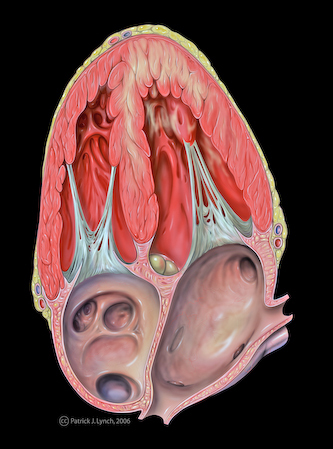 "Heart with Anterior Wall Dysfunction", image by Patrick J. Lynch Indeed there is a risk of a heart attack, or "cardiac arrest", when running a marathon. Or a 5Km race. Or jogging, cycling, shoveling snow, or sitting in a comfy chair.
Not that those risks are equal, but people do have heart attacks under a variety of conditions.
More Promotion for my Marathon Running versus Heart Attack Article
Writing Tip
Today 's writing tip is new to this blog, so pay attention!The disclaimer is an important part of any article that gives advice that is risky, in any way, shape or form. Various online magazine sites suggest "boilerplate" disclaimers...no doubt vetted by their lawyers. Take note of the best disclaimers from your favourite authors or sites, and be sure to include your version whenever appropriate.In the above DeHaan Fitness article, I said:Disclaimer: The information contained in this article is for educational purposes only and should not be used for diagnosis or to guide treatment without the opinion of a health professional. Any reader who is concerned about his or her health should contact a doctor for advice. I actually used two disclaimers in a fairly recent Suite 101 article, " What is Probiotic, What is Prebiotic, and Why People Should Care". To summarize the writing tip: include a disclaimer when offering advice or opinions, and/or when someone might be tempted to "try it at home" and harm themselves.
When I've created original images for an article at on online magazine, I like to publish the pictures here first. Please read the whole article in Decoded Science. " The Pitfall that Conditional Probability is Not Commutative" continues a series by highlighting a pitfall for unwary mathematicians. Three Original Images for Conditional Probability
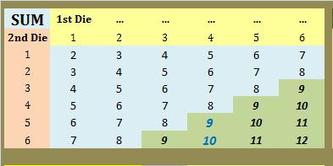 Probability of the Intersection Sum of Two Dice", image by Mike DeHaan First is the image showing the dice rolls that result in the sum of 9, 10, 11 or 12.
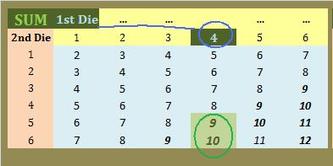 "Conditional Probability Given First Dice", image by Mike DeHaan The second picture shows the condition that the first die comes up '4'. Note how few choices remain for scoring the total of 9-12.
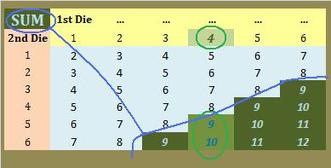 "Conditional Probability Given the Sum", image by Mike DeHaan Third comes the image illustrating the conditional probability of "Given that the total is indeed in the range of 9-12, what are the chances that the first die really was a '4' after all"?
Other Articles
Once the Decoded Science article is published, I will also promote it in DeHaan Services (" One Pitfall for Conditional Probability") and in my Xanga blog (" Take Care with Conditional Probability"). As I explain below in "An SEO Link Experiment Begins", I'm also providing one link to my reference material. In this situation, it happens that my only resource was " Conditional Probability" by Eric W Weisstein at MathWorld Wolfram. Writing Tips
Regular readers will recognize these writing tips.
First, publish your original images where you along can claim copyright for them. Your blog is a good place!
Second, publish the caption with the image, such as my "image by Mike DeHaan".
Third, it's best to start the caption with key words you want to emphasize for your main article. Add the words "picture" or "image" to clarify that this reference is not a whole article, just another pretty picture. Finally, despite the way I do it, some wise people recommend that one omit the quotes ("). Personally, I prefer to use them, especially when the web editor does not handle italics or special fonts to set the caption apart from the main text.
An SEO Link Experiment Begins
Recently, I read some discussions about the SEO value of linking forward from one's own article to a trustworthy article on the same topic. "SEO" means to "Search Engine Optimization", which is a group of techniques aimed at placing one's articles higher in search engine results for the desired keywords. In the middle of January, 2012, the PageRank for my Blog of Writing here on Weebly is '3'. So is my DeHaan Services site. However, the Wolfram Mathworld site has PageRank '8'. PageRank is a number from zero to ten, as far as I know, that indicates how authoritative a site or article is...compared to everything else on the Internet. Higher numbers are better. New sites are "unranked". The experiment is to add one high page-rank reference link to my promotional articles. Let's see whether I can find a difference in the number of page-views for my publicity articles, and especially for the online magazine articles that I'm promoting.I will also go back to a few older promotional articles, just to speed up the process.
On Jan. 12, 2012, I achieved the rare feat of publishing three articles, at three sites, with different views of the same underlying subject: Rhodiola rosea.
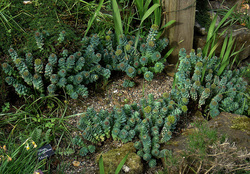 "Colony of Rhodiola rosea in Eurasia", image by peganum _Rhodiola rosea is an herb of the Northern hemisphere.
_ Rhodiola rosea in Environmental Graffiti
__" Rhodiola: The Northern Hemisphere's Favorite Medicinal Herb" puts the focus on the plant, and its known history as food and folk medicine. The article touches lightly on modern uses. _Rhodiola rosea in Suite 101
_" Rhodiola rosea Might Have a Future in Alternative Medicine" takes the more modern approach, but is informed by the folk medicine and herblore of the past. _Rhodiola rosea in DeHaan Fitness
_" Caution about Using Rhodiola to Enhance Sports Performance" is hosted on the site that truly started the action. A reader had asked recommended Rhodiola as a product, in a comment on another article. Although I had permitted the comment, I also noted that I could not endorse what I had not researched. When the reader asked me to do so, I was flattered and followed up. Writing Tip
Here is a double writing tip.
First, be open to suggestions from readers.
Second, do your own research anyway.
Publicity for my Rhodiola rosea Articles
As always, I also promote my articles...yes, all three...in my DeHaan Services site (" Triple Coverage for Rhodiola rosea") and in my Xanga blog (" Rhodiola rosea in Triplicate"). (Updated 2012-01-17) As noted in a later article, I will include a link to one article that I used for reference. EBSCO Publishing, NY University Langone Medical center, " Rhodiola rosea: Principal Proposed Uses; Other Proposed Uses"
[ Updated 2012-01-13]. As I began to write my Decoded Science article, " An Introduction to Conditional Probability in Mathematics", I wanted to achieve two online writing tasks. First, I had to test the HTML for the "is an element of" symbol. Second, I wished to lay claim to my original "artwork" based on a spreadsheet I developed. The Element Symbol in HTML
This is the "Custom HTML" widget as provided by Weebly. My first guess is that the "Element" symbol might be an ampersand followed by "elem;". Here goes: ( &elem; ). Success or fail? FAIL! I then researched this in a reference site. It should be an ampersand followed by "isin;" ("is in"). Here is is: ( ∈ ). SUCCESS! I based this test on a WordPress plug-in for symbols that calls the Euro coin symbol an ampersand followed by "euro;". Here goes: ( € ). I Hereby Claim Original Artwork
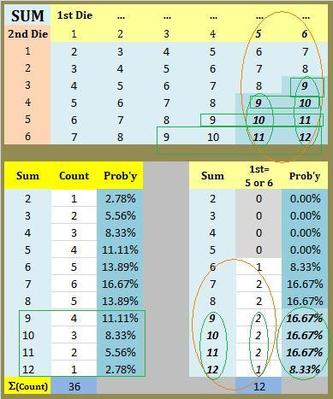 "Conditional Sum of Two Dice", image by Mike DeHaan Claiming original artwork is simple: just be the first to post your home-made image online. As always, I also promote my article in DeHaan Services (" Introducing the Math of Conditional Probability" ) and in my Xanga blog (" Starting with Conditional Probability"). ( Updated 2012-01-17) As I explain in " Preview of Non-Commutative Conditional Probability", I will also include a link to one article that I used for reference: Weisstein, Eric W. " Conditional Probability". MathWorld--A Wolfram Web Resource.
Writing Tip
Today's writing tip is: do your research if you need something. I found the "element is in" symbol in the W3Schools site's " HTML Symbol Entities Reference" page.
One technique for selecting a topic is to use the Google "Insights for Search" site without selecting a topic, but with limiting the request to a geographic region.
Today I decided to see what my home province of Ontario (Canada) has been seeking through Google over the last seven years.
The usual suspects are major web sites such as Facebook and Google itself. Generally I don't find those subjects inspiring, at least not as topics for articles that I'm going to write.
However, one result jumped out at me. Let me share the picture:
"TD" was a Popular Search in Ontario
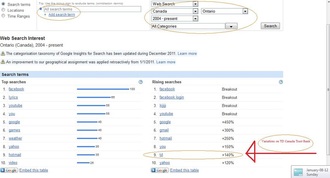 Ontario Google Searches on Jan. 8, 2012; image by Mike DeHaan The highlighted image shows that "TD" was a "rising" search topic over that period of time. By clicking on "TD", I found it does indeed represent the bank "TD Canada Trust". The many specific terms were variations on the bank's name and its online services. Oddly enough, "TD" was not the top search result within the "Financial Services" category. How then did "TD" outrank the other banks across all categories? Was there another category for "TD"? Yes. I have no idea why "TD" had additional popularity in the "Arts and Entertainment" category, but who am I to criticize Google's decisions?(Quickly added): Facebook buddy Nicholas Lee Morine noted that 'TD' might refer to the " Tower Defense" game, and thus account for the "Arts and Entertainment" category. Thanks, NLM.
Questions for Banks in Ontario Should TD Canada Trust be pleased that it ranks so highly in Google's report of searches?
Conversely, should the other banks be envious of this placement?
Should TD Canada Trust be concerned that so many Ontario residents resorted to using Google to find its web site or services? Did they choose an obscure URL? Don't their customers bookmark the bank's site?
Should TD Canada Trust ask Google why it is popular in categories other than "Financial Services"?
For the authors among my readers: Are your articles categorized as you expect? Have your readers found you with really odd keywords? Or have they searched for the exact words in your URL...showing that they did not remember how easy it is to find your site!
Writing Tip
Today's writing tip is to find and use tools such as "Google Insights for Search" to guide your plans for writing articles for your online audience.
This particular tool shows what key phrases are popular for users searching through Google.
If you write about a popularly-searched topic, you have some chance that people will read your article. If no-one seeks for your wisdom, it is unlikely anyone will find or read your words.
"Google Insights for Search" does not tell you how much competition already exists. If millions of other authors already promote those keywords, you will have trouble getting noticed.
It does not tell you how much, if anything, advertisers would pay for placing an ad on your site because of that keyword. If no-one else expects to make a profit on the keyword, then you are also unlikely to earn anything.
Nonetheless, "Google Insights for Search" is a valuable research resource.
_Today Decoded Science published my " Taste of the 2012 Joint Mathematics Awards and Prizes". I'm pleased to say it is the first official "news" article I have written anywhere. 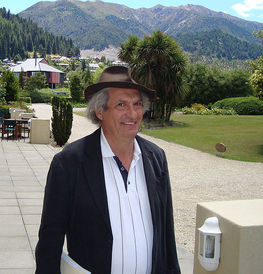 "Professor of Statistics and Mathematics Persi Diaconis", picture by Persi Diaconis _Decoded Science is privy to press releases from various science bodies, so it can report on news as it becomes available. It also has "news provider" status with Google. The Decoded Science standard is to conduct and include an exclusive interview for its "Headline" category of news articles. As always, my article is publicized in DeHaan Services (" Prizes Awarded at the Joint Mathematics Convention, Jan. 5, 2012") and in Xanga (" Recognition for Mathematicians at Annual Convention in Jan. 2012"), simply to offer more readers the chance to find the main article.
Writing Tip
_Today's writing tip involves news reporting.
Google sets and maintains its standards for what constitutes "news", and reports such articles in its search results. Online writers who want to contribute "recognized" news articles, and receive the quick uptake of extra page views, might best learn this craft by contributing to online magazine sites that already have this relationship with Google.
Here is a bonus writing tip. Always find some way to add value for your reader. Often I try to find an unusual relationship among items in a news release, but an unquestionable bonus is the exclusive interview.
|













 RSS Feed
RSS Feed